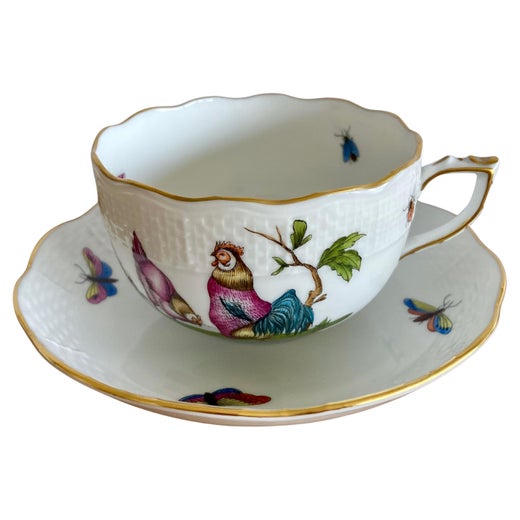Herend Rothschild Bird Oversized Tureen With Lemon Handle and Large Platter
About the Item
- Creator:Herend (Manufacturer)
- Dimensions:Height: 12.5 in (31.75 cm)Width: 18.5 in (46.99 cm)Depth: 14 in (35.56 cm)
- Sold As:Set of 3
- Style:Romantic (In the Style Of)
- Materials and Techniques:
- Place of Origin:
- Period:
- Date of Manufacture:1950-1960
- Condition:This tureen and platter are in very good condition.
- Seller Location:Boston, MA
- Reference Number:1stDibs: LU5389240304512
Herend
Herend Porcelain occupies a singular place in the world of luxury European ceramics. The firm's vast range of figurines and distinctive patterns are visually striking and notably different from those of other major porcelain producers like Meissen or Sèvres. Whereas the latter tend to feature discrete decorative elements that appear to float on a white background, Herend favors large, bold designs for its porcelain, with its serving pieces, dishes and other works incorporating historical scenes, animals or vegetation.
Vince Stingl established what would become the Herend Porcelain Manufactory in 1826 in the town of Herend, Hungary, to produce earthenware. When he went bankrupt in the late 1830s, Mór Fischer, who took over, switched the focus from earthenware to porcelain to take advantage of the growing European market for fine china.
By 1849, Herend counted among its clients members of the Habsburg dynasty and the Hungarian aristocracy. Thanks to its participation in several important international exhibitions and fairs — including the 1851 Crystal Palace Exhibition in London, the 1853 Exhibition of the Industry of All Nations in New York and the 1855 Exposition Universelle in Paris — its wares became a popular choice for courtly dining in the middle of the 19th century, and its patrons included Francis Joseph I of Austria and Queen Victoria of England, for whom its Viktória pattern was named.
The company foundered in the latter half of the 19th century under the leadership of Fischer’s two sons. But it was given new life, artistically and financially, when Fischer’s grandson, Jenő Farkasházy, himself a trained ceramist, took the helm around 1900. Farkasházy designed new patterns and revived classic ones. After World War II, Herend was nationalized by the Communist government but kept alive its tradition of skilled craftsmanship by continuing to produce its classic patterns. In 1993, after the fall of the Iron Curtain, the factory was privatized once again and today is owned by its management and workers.
Authentic Herend animal figurines — their groupings of white rabbits, cats or pheasants — are often covered head to toe with the factory’s famed “fish-scale” pattern, also known as Vieux Herend, which produces the effect of a dense coat of feathers or fur. The fish-scale pattern also appears on this chocolate cup and saucer decorated in the Cornucopia pattern.
Find antique Herend porcelain on 1stDibs.
You May Also Like
Vintage 1980s Hungarian Soup Tureens
Gold Leaf
Late 20th Century Hungarian Queen Anne Soup Tureens
Porcelain
Late 20th Century Hungarian Queen Anne Soup Tureens
Porcelain
Early 20th Century German Soup Tureens
Porcelain
Vintage 1930s French Soup Tureens
Majolica
1990s American Soup Tureens
Silver Plate
Early 20th Century Unknown Art Nouveau Soup Tureens
Silver Plate
20th Century French Soup Tureens
Porcelain
Vintage 1920s German Soup Tureens
Porcelain
20th Century Hungarian Porcelain
Porcelain
